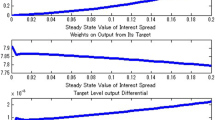Abstract
This article implements an Augmented Lagrangian algorithm to compute equilibria in a general equilibrium model with incomplete markets and default. It is one of the first attempts to solve such a model on a large scale. Convergence is found for various economic parameters. We illustrate the effectiveness of this approach for simulating general equilibrium economies with a default.
Similar content being viewed by others
Notes
We say that the CPLD condition is satisfied at a feasible point x if the linear dependence of gradients of active constraints with non-negative coefficients corresponding to inequalities implies the linear dependence of the same gradients in a neighborhood of x.
References
Andreani, R., Birgin, E. G., Martinez, J. M., & Schuverdt, M. L. (2007). On augmented Lagrangian methods with general lower-level constraints. SIAM Journal on Optimization, 18, 1286–1309.
Birgin, E. G. http://www.ime.usp.br/~egbirgin/tango/.
Brown, D. J., DeMarzo, P. M., & Eaves, B. C. (1996). Computing equilibria when asset markets are incomplete. Econometrica, 64, 1–27.
Chen, X. (2012). Smoothing methods for nonsmooth, nonconvex minimization. Mathematical Programming, 134, 71–99.
DeMarzo, P. M., & Eaves, B. C. (1996). Computing equilibria of GEI by relocalization on a Grassmann manifold. Journal of Mathematical Economics, 26, 479–497.
Dubey, P., Geanakoplos, J., & Shubik, M. (2005). Default and punishment in general equilibrium. Econometrica, 73, 1–37.
Esteban-Bravo, M. (2008). An interior-point algorithm for computing in economies with incomplete asset markets. Journal of Economic Dynamics & Control, 32, 677–694.
Facchinei, F., Jiang, H., & Qi, L. (1999). A smoothing method for mathematical programs with equilibrium constraints. Mathematical Programming, 85, 107–134.
Fukushima, M., & Hu, M. (2012). Smoothing approach to Nash equilibrium formulations for a class of equilibrium problems with shared complementarity constraints. Computational Optimization and Applications, 52, 415–437.
Fukushima, M., & Qi, L. (1999). Reformulation: nonsmooth, piecewise smooth, semismooth and smoothing methods. Dordrecht: Kluwer.
Geanakoplos, J. (1997). Promises, promises. In W. B. Arthur, S. N. Durlauf, & D. A. Lane (Eds.), The economy as an evolving complex system II (pp. 285–320).
Geanakoplos, J., & Zame, W. (2007). Collateralized asset markets. Discussion paper, Yale University.
Herings, P., & Kubler, F. (2002). Computing equilibria in finance economies. Mathematics of Operations Research, 27, 637–646.
Hestenes, M. R. (1969). Multiplier and gradient methods. Journal of Optimization Theory and Applications, 4, 303–320.
Judd, K. L., Kubler, F., & Schmedders, K. (2003). Computational methods for dynamic equilibria with heterogeneous agents. In M. Dewatripont, L. Hansen, & S. Turnovsky (Eds.), Advances in economics and econometrics: theory and applications, eighth world congress, (Vol. III, pp. 243–290). Cambridge: Cambridge University Press.
Kubler, F., & Schmedders, K. (2000). Computing equilibria in stochastic finance economies. Computational Economics, 15, 145–172.
Kubler, F., & Schmedders, K. (2003). Stationary equilibria in asset-pricing models with incomplete markets and collateral. Econometrica, 71, 145–172.
Magill, P., & Shafer, W. (1991). Incomplete markets. In W. Hildenbrand & H. Sonnenschein (Eds.), Handbook of mathematical economics (pp. 1523–1614). New York: North-Holland.
Modica, M., Rustichini, A., & Tallon, J.-M. (1998). Unawareness and bankruptcy: a general equilibrium model. Economic Theory, 12, 259–292.
Nesterov, Y. (2005). Smooth minimization of non-smooth functions. Mathematical Programming Series A, 103, 127–152.
Powell, M. J. D. (1969). A method for nonlinear constraints in minimization problems. In R. Fletcher (Ed.), Optimization (pp. 283–298). New York: Academic Press.
Qi, L., Tong, X., Wu, F., & Zhou, H. (2010). A smoothing method for solving portfolio optimization with CVaR and applications in allocation of generation asset. Applied Mathematics and Computation, 216, 1723–1740.
Rockafellar, R. T. (1974). Augmented Lagrange multiplier functions and duality in nonconvex programming. SIAM Journal on Control and Optimization, 12, 268–285.
Schmedders, K. (1998). Computing equilibria in the general equilibrium model with incomplete asset markets. Journal of Economic Dynamics & Control, 22, 1375–1401.
Schommer, S. http://sites.google.com/site/susanschommersite/software/.
Author information
Authors and Affiliations
Corresponding author
Additional information
I am grateful to my advisor Aloisio Araujo and also to Felix Kubler, José Mario Martínez and Rodrigo Novinski for comments and suggestions. I am especially indebted to Artur Avila for several discussions on the implementation of the algorithm. I would also like to thank the referees for their detailed comments, in particular regarding the presentation and the choice of initial points. This work was supported by CNPq.
Rights and permissions
About this article
Cite this article
Schommer, S. Computing equilibria in economies with incomplete markets, collateral and default penalties. Ann Oper Res 206, 367–383 (2013). https://doi.org/10.1007/s10479-012-1276-1
Published:
Issue Date:
DOI: https://doi.org/10.1007/s10479-012-1276-1




